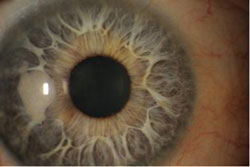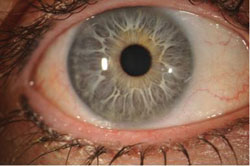Management of a recalcitrant epithelial ingrowth after LASIK
A case is presented to illustrate the surgical management of recurrent epithelial ingrowth 12 years after LASIK.
Epithelial ingrowth is the presence of corneal epithelium between the interface of the LASIK flap and the stromal bed. Typically, epithelial ingrowth is limited to the peripheral regions of the corneal flap and has no clinical significance. Clinically significant epithelial ingrowth occurs when irregular corneal astigmatism leads to decreased vision, direct intrusion of cells into the visual axis or even melting of the overlying flap.
Development of significant epithelial ingrowth is rare, occurring in 1.7% to 2.3% of mechanical microkeratome-assisted LASIK flap lift re-treatments and 0% to 0.92% of primary LASIK cases. With femtosecond-assisted flap creation, the reported incidence of epithelial ingrowth is 0.03% for primary LASIK and 1.85% for flap lift re-treatments.
We present a case to describe the surgical management of recurrent epithelial ingrowth 12 years after LASIK.
Case report
A 49-year-old woman was referred for evaluation of her recurrent epithelial ingrowth. The patient had mechanical microkeratome-assisted LASIK in both eyes in 1998. A LASIK enhancement with flap lift was performed on the right eye in spring 2009, along with limbal relaxing incisions in fall 2009.
Ten months after enhancement, uncorrected distance visual acuity was 20/200 in the right eye and 20/50 in the left eye. Manifest refraction (–0.50 +5.00 × 66; –1.25 +0.50 × 155) corrected vision to 20/30 in the right eye and 20/20 in the left eye. Ophthalmologic examination revealed a 1 mm × 1 mm nasal area of epithelial ingrowth. Medical history was significant for hypothyroidism, controlled with medications.
Because of the decrease in visual acuity, the epithelial ingrowth was removed by an outside ophthalmologist. The patient’s visual acuity improved for 6 to 9 months after ingrowth removal. However, gradual blurring of vision in the right eye returned over the next several months.
The patient returned to our clinic 17 months later with a manifest refraction of –1.25 +5.00 × 085 in the right eye and –1.50 +0.50 × 85 in the left eye. Slit lamp examination revealed white nests of cells temporally at the flap interface, from the 5 o’clock to the 11 o’clock position, measuring 4.2 mm × 3.6 mm (Figures 1 and 2).
 Figure 1. Slit lamp photograph of the recurrent epithelial ingrowth seen as a solitary island or nests of cells. Necrosis is visible on the temporal edge. |
 Figure 2. Slit lamp photograph shows magnified view of the nests of cells close to the edge of the flap. Images: Moshirfar M, Hsu M, Anderson E
|
 Figure 3. Slit lamp photograph at 2.5 weeks postop. Of the 15 sutures, only five remain with a bandage contact lens in place. |
 Figure 4. Slit lamp photograph at 1 month after surgery, with no signs of epithelial ingrowth. |
Given the enlargement of the area of ingrowth, surgical removal was performed. After retrobulbar anesthesia was administered, the LASIK flap was lifted. Epithelial ingrowth was removed with Weck-Cels. This area was then smoothed with a Grieshaber blade to ensure all epithelial ingrowth was removed. The LASIK flap was then repositioned and secured with 15 10-0 nylon sutures. Tisseel glue (Baxter) was placed over the area, and a bandage contact lens was placed after 3 minutes. Zymaxid (gatifloxacin ophthalmic solution 0.5%, Allergan) four times daily was started, decreasing to two times a day after 1 week while a bandage contact lens was used. Prednisolone 1% every 2 hours was also started and was tapered over the subsequent 3 weeks.
On the first postoperative day, visual acuity was 20/400 in the right eye. Slit lamp exam showed mild corneal edema but no epithelial ingrowth. One week after surgery, the first five sutures were removed, with another five removed at 2 weeks postoperatively in an alternating fashion (Figure 3). The last sutures were removed at 3 weeks. One month after surgery, uncorrected distance visual acuity was 20/30, with no signs of epithelial ingrowth (Figure 4). The bandage contact lens was removed, and superior and inferior collagen punctal plugs were placed. The patient was continued on frequent artificial tears to prevent recurrence of epithelial ingrowth.
Discussion
The mechanism by which flap lift re-treatment elicits epithelial growth remains to be elucidated. Likely the manipulation of the flap causes poor flap apposition, allowing for a pathway of epithelium to the stromal bed. On average, the higher rate of occurrence in mechanical microkeratome- vs. femtosecond-assisted flap creation can be attributed to the increased mechanical disturbance of the epithelium that mitigates growth.
Surgical treatment is generally needed when there is decreased vision or a flap melt. The most common removal technique involves lifting the flap and mechanically debriding the flap undersurface and stromal bed surfaces to remove the tissue, with or without placement of a bandage contact lens. Flap suturing and fibrin glue are used in aggressive cases or after repeat ingrowth removal. Untreated epithelial ingrowth can produce transient or permanent loss of vision from induced astigmatism, stromal scarring or lamellar flap melt.
The method of treatment also depends on the length of time since the primary LASIK. When flap lift re-treatment is performed 3 or more years after primary LASIK, the incidence of significant epithelial ingrowth is 7%, compared to 1% when re-treatment is performed prior to 3 years after primary LASIK. If the primary LASIK occurred fewer than 3 years earlier, flap lift re-treatment can be performed with roughly a 1% risk for clinically significant epithelial ingrowth. After 3 or more years, the clinician may elect to perform PRK over the previous LASIK flap to avoid increased risk for clinically significant epithelial ingrowth.
As we have shown, it is still reasonable to proceed with flap lift re-treatment even when the primary LASIK was performed 3 or more years prior. However, the patient should be educated on the increased risk of occurrence, which is 8%. The flap lift re-treatment technique is also preferable to PRK in terms of patient pain and disability.
References:
- Caster AI, Friess DW, Schwendeman FJ. Incidence of epithelial ingrowth in primary and re-treatment laser in situ keratomileusis. J Cataract Refract Surg. 2010;36(1): 97-101.
- Kamburoglu G, Ertan A. Epithelial ingrowth after femtosecond laser-assisted in situ keratomileusis. Cornea. 2008;27(10):1122-1125.
- Letko E, Price MO, Price FW Jr. Influence of original flap creation method on incidence of epithelial ingrowth after LASIK re-treatment. J Refract Surg. 2009;25(11):1039-1041.
- Wang MY, Maloney RK. Epithelial ingrowth after laser in situ keratomileusis. Am J Ophthalmol. 2000;129(6): 746-751.
For more information:
- Majid Moshirfar, MD, can be reached at the John A. Moran Eye Center, University of Utah, 65 Mario Capecchi Drive, Salt Lake City, UT 84132; 801-581-2352; email: majid.moshirfar@hsc.utah.edu.
- Disclosure: Dr. Moshirfar has no relevant financial disclosures.
